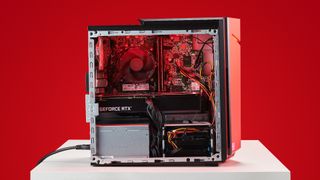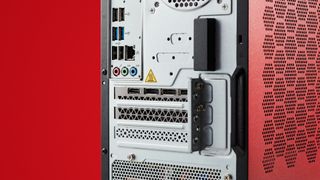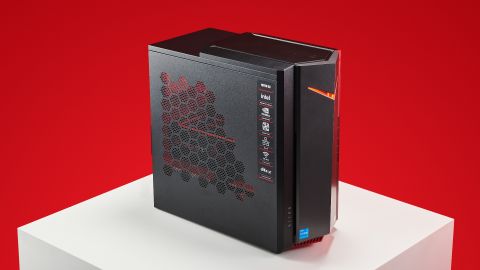Our Verdict
When you can get an RTX 3060 Ti-powered machine with double the SSD space for just $100 more, it's really hard to recommend a machine like this. 238GB of NVMe storage just isn't enough, and the HDD won't save you—however large it is.
For
- Attractive case (for edgelords like me)
- Nice CPU/GPU combo
Against
- Storage solutions are weak
- Knotted wiring
- Proprietary everything
- Runs pretty hot
PC Gamer's got your back
Packaged snugly in a bite size box, this small form-factor Acer Nitro PC feel like it's got a bit of a Napoleon complex going on. The angry, red LED brow on the front of the machine sits beside possibly the largest power button I've ever seen, as if to say, "Press it and I will end you." Though that attitude isn't entirely baseless—the mid-range CPU/GPU combo can handle itself in a host of games at 1440p.
In theory, that combo should be great for productivity-style tasks, too, but the storage really lets it down.
Bolstering a pretty miniscule 238GB PCIe SSD boot drive with an HDD (even a 1TB one) is, frankly, a mistake. Just pick a bigger solo boot SSD, people. Here it means I'm not able to play the majority of today's games with the speedy load times an M.2 solid state drive would have provided. Case in point, the FFXIV Shadowbringers benchmark choked at 32.9 seconds when loading from the hard drive; in this day and age that's pretty unacceptable.
If you do manage to fit anything on the SSD, you're looking at around 12.7 seconds load time, and even that's a little lacking compared to other PCs in the same, and even in lower price brackets.
CPU: Intel Core i5 12400F
GPU: Acer Predator GeForce RTX 3060
RAM: Kingston 16GB DDR4-3200
Motherboard: Acer proprietary Intel B660
Storage: Kingston OM8PDP3256B-AA1 238.5GB SSD
Front I/O: 1x USB 3.2 Gen 2 Type-A, 1x USB 3.2 Gen 2x2 Type-C, mic in, headphone
Rear I/O: 4x USB 2.0 Type-A, 2x USB 3.2 Gen 1 Type-A
Connectivity: Wi-Fi 6, Bluetooth 5.0
PSU: 500W
Case: Acer Nitro 50
OS: Windows 11 Home
Warranty: 1 year standard
Price: $1, 300
The 3DMark Storage Benchmark furthers my concerns there, with only a passable 1,381 index score for the SSD, and just managing an abysmal 155 points for the HDD. Basically, expect to spend a lot of time on read/write tasks. This is likely the main reason the Nitro stumbled in the PCMark 10 Express benchmark, too, with a score of 5,757.
On the plus side, you can't buy this exact spec. Acer has, in its infinite wisdom, decided to send us a machine for review you can't buy. The system you can buy comes with a far more reasonable 512GB PCIe SSD for your $1,300. It's still hooked up with a 1TB hard drive, so the data side is still slow, but that takes away a lot of our immediate issues with the Nitro 50.
That's unlikely to change the PCMark score, which would indicate general productivity isn't its strong suit. But the Aida64 Extreme benchmark score of 41,015 shows the dual channel 16GB DDR4-3200 RAM can handle the stresses of multitasking pretty well.
That RAM will give you a better chance when it comes to gaming too, and once you've spent the majority of your day installing your games on the HDD (ridiculous), the Nitro 50 does manage to pack a punch when it comes to gaming. That's thanks to the solid combination of entry-level core components: an Nvidia GeForce RTX 3060 and Intel Core i5 12400F.

System benchmarks









Even as a last generation CPU, the Core i5's got a lot going for it with single core Cinebench R23 scores of 1,697, and multi core scores of 11,595. That gives it an edge in rendering, and an average synthetic performance of 34.14 fps when testing with X264 v5.0.1. That's all a good indication of the i5 12400F's great gaming potential, and although it's no match for the $200 more expensive iBuyPower's Core i7 12700f in terms of multicore performance, maybe think of it as paying yourself $200 to wait a little longer for rendering.
The 4K 3DMark Time Spy Extreme benchmark did give it a little trouble though. A CPU score of 4,068 is lacking compared to other machines we've tested, which will be down to the RTX 3060's contribution; this is really not the card for 4K.
In actual gaming benchmarks, the CPU saw 82fps averages in Hitman 3 Dartmoor—that's on ultra graphics settings at 1440p, with sim quality set to best. Not a terrible score, especially when you put it next to 43 fps averages in Metro Exodus Enhanced. The F1 22 performance with ray tracing on was underwhelming at 29fps, though the test was done on the rainy Belgium track with anisotropic filtering at x16, and graphics set to ultra high. It never did drop below 26fps though, so it still remained playable. You can definitely hit smoother frame rates with a little settings tinkering, which is the general ethos of this machine.
The rest of the gaming benchmarks were all done at 1440p on ultra settings, and all were more than playable thanks to the core components, though for an additional $99 you could have yourself the NZXT Streaming PC that manages another 20fps in Far Cry 6, 18fps in Hitman Dartmoor, and 17fps in Metro. It doesn't sound like a lot, but considering the great thermals and more impressive (and larger) NVMe SSD, it's almost a no-brainer.

Gaming benchmarks






The Nitro is a nifty machine for gaming it's really been let down on the storage side.
The main problem with high powered components, however, comes in the form of heat dissipation. The Nitro's small form factor case with minimal vents doesn't help in that respect; we're talking max CPU and GPU temps in the low 80°C. It's not the worst we've seen and won't have your components melting, but it could certainly be better.
The bottom line here is that, while the Nitro is a nifty machine for gaming it's really been let down on the storage side. The config we were expecting to have in the lab is this Nitro 50 at $1,300 with a larger SSD, though Acer has still felt the need to jam a hard drive in there. Honestly, that machine would perform at about the same level as the one in front of us here, and with that larger boot drive would have garnered a far higher score, too.
Sure, I would have been much happier with even a single, speedy 1TB SSD, rather than some additional spinning platter nonsense, but a 512GB drive is the bare minimum for a modern gaming PC. You can easily upgrade the storage later or add some more into one of the two spare M.2 slots, but these storage shenanigans really make the Nitro hard to recommend.
When you can get an RTX 3060 Ti-powered machine with double the SSD space for just $100 more, it's really hard to recommend a machine like this. 238GB of NVMe storage just isn't enough, and the HDD won't save you—however large it is.

Screw sports, Katie would rather watch Intel, AMD and Nvidia go at it. Having been obsessed with computers and graphics for three long decades, she took Game Art and Design up to Masters level at uni, and has been rambling about games, tech and science—rather sarcastically—for four years since. She can be found admiring technological advancements, scrambling for scintillating Raspberry Pi projects, preaching cybersecurity awareness, sighing over semiconductors, and gawping at the latest GPU upgrades. Right now she's waiting patiently for her chance to upload her consciousness into the cloud.
